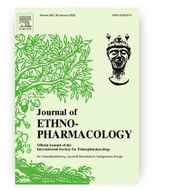Antibacterial and therapeutic potential of historic deposits of Silesian healing clay – terra sigillata Silesiaca
Izabela Spielvogel; Elżbieta Gębarowska; Krzysztof Badora; Jarosław Waroszewski; Karolina Budek; Jarosław Proćków; Bernard Gałka; Tomasz Gębarowski
Journal of Ethnopharmacology
Ministerial score = 140.0
Journal Impact Factor (2023) = 4.8 (Q1)
 Ethnopharmacological relevance The increasing evolution of pathogen resistance is a global problem that requires novel solutions. Recently, an increased interest in ethnomedicinal sources can be observed in the derivation of new medicines. The return to traditional medicinal formulations handed down for generations is being followed, but it is necessary to revise them again, taking into account the generally accepted research protocol. Aim of the study We aimed to evaluate the antimicrobial potential of historical deposits of Silesian healing clay (SHC), used in ethnomedicine against Gram-positive bacteria and to assess their biological activity using a primary dermal fibroblast line (NHDF) and a model monocyte line (THP1). Materials and Methods Information on medicinal clay deposits that occur in Silesia and are traditionally used in ethnomedicine or ancient medicine and known as terra sigillata Silesiaca or SHC, was selected on available source materials and old prints and maps from the archives of the Polish Geological Institute (Wrocław, Poland). Subsequently, their places of occurrence were identified and traced in the field by taking three deposits from the Silesia territory: Upper Silesia (D1), Opole Silesia (D2), and Lower Silesian (D3) Voivodeships for analysis. Their basic parameters and antimicrobial efficacy against pathogenic bacteria, Gram-positive streptococci and staphylococci, including methicillin-resistant strains, were examined. The study evaluated the effects of clays on growth and vitality using a primary dermal fibroblast line (NHDF) and a monocytic line (THP1). Studies were performed on a cell culture model to determine the effects on tissue regeneration (fibroblasts) and anti-inflammatory effects (monocytes). The study attempted to identify the mechanism of antimicrobial action, especially the textural characteristics and geochemical composition, as well as the environmental reaction (pH). Results SHCs were classified into the following textural classes: clay loam (D1), clay (D2), and sand (D3). The tested deposits have antimicrobial properties that reduce the bacterial population (104 CFU) compared to the control (108 CFU). The antimicrobial effect depends on the type of clay and the species or strain of bacteria used. In-house studies clearly showed that Staphylococcus aureus PCM 2054 and Staphylococcus epidermidis MRSE ATCC 2538 cells were completely adsorbed by clay minerals from clay D3.13. Furthermore, 10% leachates also showed an antimicrobial effect, as a reduction in bacterial populations was observed ranging from 91 to 100%. The results showed stimulation of fibroblast culture proliferation and inhibition of the growth of inflammatory cells (monocytes). Conclusion SHCs tested have antimicrobial potential, in particular D2.7, D2.11, and D3.13. The D3.13 deposit had a bactericidal effect against the staphylococci tested. Aqueous solutions of clays also showed bacteriostatic effect. The results obtained in cell culture model tests indicate properties that modulate the healing process – stimulation of fibroblast growth (NHDF line) and inhibition of monocyte growth (THP1 line).
Ethnopharmacological relevance The increasing evolution of pathogen resistance is a global problem that requires novel solutions. Recently, an increased interest in ethnomedicinal sources can be observed in the derivation of new medicines. The return to traditional medicinal formulations handed down for generations is being followed, but it is necessary to revise them again, taking into account the generally accepted research protocol. Aim of the study We aimed to evaluate the antimicrobial potential of historical deposits of Silesian healing clay (SHC), used in ethnomedicine against Gram-positive bacteria and to assess their biological activity using a primary dermal fibroblast line (NHDF) and a model monocyte line (THP1). Materials and Methods Information on medicinal clay deposits that occur in Silesia and are traditionally used in ethnomedicine or ancient medicine and known as terra sigillata Silesiaca or SHC, was selected on available source materials and old prints and maps from the archives of the Polish Geological Institute (Wrocław, Poland). Subsequently, their places of occurrence were identified and traced in the field by taking three deposits from the Silesia territory: Upper Silesia (D1), Opole Silesia (D2), and Lower Silesian (D3) Voivodeships for analysis. Their basic parameters and antimicrobial efficacy against pathogenic bacteria, Gram-positive streptococci and staphylococci, including methicillin-resistant strains, were examined. The study evaluated the effects of clays on growth and vitality using a primary dermal fibroblast line (NHDF) and a monocytic line (THP1). Studies were performed on a cell culture model to determine the effects on tissue regeneration (fibroblasts) and anti-inflammatory effects (monocytes). The study attempted to identify the mechanism of antimicrobial action, especially the textural characteristics and geochemical composition, as well as the environmental reaction (pH). Results SHCs were classified into the following textural classes: clay loam (D1), clay (D2), and sand (D3). The tested deposits have antimicrobial properties that reduce the bacterial population (104 CFU) compared to the control (108 CFU). The antimicrobial effect depends on the type of clay and the species or strain of bacteria used. In-house studies clearly showed that Staphylococcus aureus PCM 2054 and Staphylococcus epidermidis MRSE ATCC 2538 cells were completely adsorbed by clay minerals from clay D3.13. Furthermore, 10% leachates also showed an antimicrobial effect, as a reduction in bacterial populations was observed ranging from 91 to 100%. The results showed stimulation of fibroblast culture proliferation and inhibition of the growth of inflammatory cells (monocytes). Conclusion SHCs tested have antimicrobial potential, in particular D2.7, D2.11, and D3.13. The D3.13 deposit had a bactericidal effect against the staphylococci tested. Aqueous solutions of clays also showed bacteriostatic effect. The results obtained in cell culture model tests indicate properties that modulate the healing process – stimulation of fibroblast growth (NHDF line) and inhibition of monocyte growth (THP1 line).
DOI:10.1016/j.jep.2024.118853









